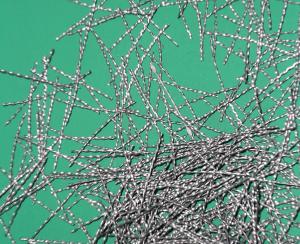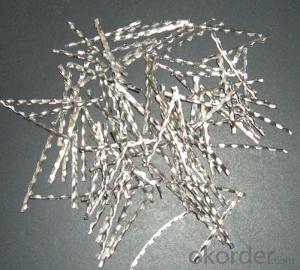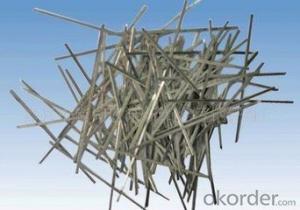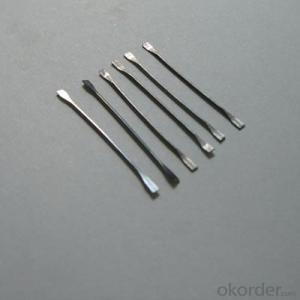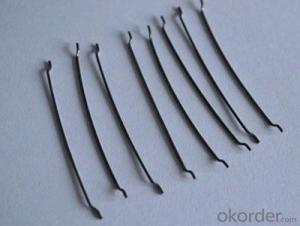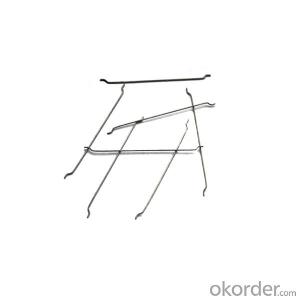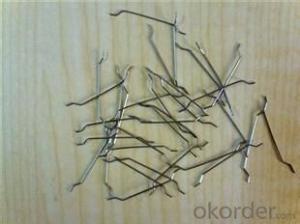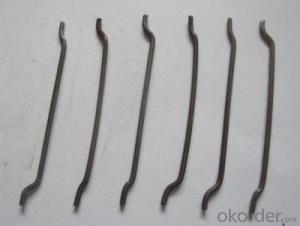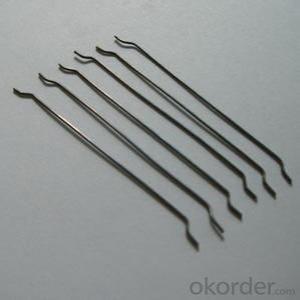Steel Fiber Copper Coated Company From CNBM International
- Loading Port:
- Tianjin
- Payment Terms:
- TT OR LC
- Min Order Qty:
- 1000 kg
- Supply Capability:
- 30000 kg/month
OKorder Service Pledge
OKorder Financial Service
You Might Also Like
Quick Details
Place of Origin: Jiangsu, China (Mainland)
Model Number: HT-ST
Material: Steel
Specifications
The raw material is stainless steel ingots, using electric stoves which melt the stainless steel ingots to become 1500 ~ 1600 ℃ steel liquid, and then with a grooved high speed rotating melt-extracting steel wheel which produces wires that meets are our customers’ specific requirements. When melting down to a wheel steel liquid surface, the liquid steel blow out by slot with centrifugal force at extremely high speed with cooling forming. Melting wheels with water keep the cooling speed. This method is done to produce different material, different sizes of steel fiber.
| SIZE | CHEMIC ELEMENT(%) | ||||||
| C | P | Mn | Si | Cr | Ni | Al | |
| AISI330 | ≤0.40 | ≤0.04 | ≤2.00 | ≤0.75 | 17~20 | 33~37 | |
| AISI310 | ≤0.40 | ≤0.04 | ≤2.00 | ≤1.50 | 24~26 | 19~22 | |
| AISI316 | ≤0.40 | ≤0.04 | ≤2.00 | ≤1.00 | 16~18 | 10~14 | |
| AISI314 | ≤0.40 | ≤0.045 | ≤2.00 | 1.5-3.0 | 23~26 | 19~22 | |
| AISI309 | ≤0.40 | ≤0.04 | ≤2.00 | ≤1.00 | 22~24 | 12~15 | |
| AISI304 | ≤0.40 | ≤0.04 | ≤2.00 | ≤2.00 | 18~20 | 8~10 | |
| AISI301 | ≤0.40 | ≤0.04 | ≤2.00 | ≤2.00 | 16~18 | 6~8 | |
| AISI201 | ≤0.40 | ≤0.06 | 5.5~7.5 | ≤1.00 | 16~18 | 3.5~5.5 | |
| AISI446 | ≤0.40 | ≤0.04 | ≤1.50 | ≤2.00 | 23~27 | ||
| AISI430 | ≤0.40 | ≤0.03 | ≤1.00 | ≤2.00 | 16~18 | ||
| NAS430A | ≤0.40 | ≤0.03 | ≤0.50 | ≤0.50 | 16~18 | 2~4 | |
| SIZE(mm) | ||||
| length | 20 | 25 | 30 | 35 |
| width | 0.75~1.5 | 0.75~1.5 | 0.75~1.5 | 0.75~1.5 |
| thickness | 0.2~0.75 | 0.2~0.75 | 0.2~0.75 | 0.2~0.75 |
Picture
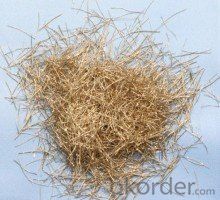
Steel fiber
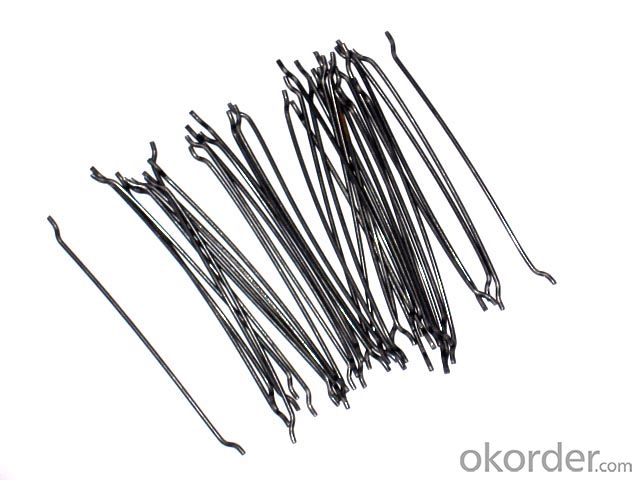

FAQ
certificated: ISO 9001
Technical advantages of Daye steel fiber:
A. Improve mechanical performance of concrete
B. Provide uniform distribution throughout concrete with excellent mixing
C. No balling or caking by adopt correct mixing method
D. Reduce concrete volume
E.Save construction time and cost
F.Reduce excavation volume
G.Available for jointless floor.
- Q:Can melt extract stainless steel fiber be used in tunnel shotcrete lining applications?
- Absolutely, tunnel shotcrete lining applications can utilize melt extract stainless steel fiber. This particular fiber is widely employed to augment the mechanical characteristics of shotcrete, including tensile strength, flexural strength, and impact resistance. Moreover, the inclusion of melt extract stainless steel fibers can elevate the durability and longevity of shotcrete, rendering it ideal for tunnel applications where sustained performance is of utmost importance. Typically, these fibers are blended into the shotcrete mixture, thereby strengthening the overall structural integrity of the tunnel lining. All in all, melt extract stainless steel fibers present a dependable and efficient option for reinforcing tunnel shotcrete linings.
- Q:Can melt extract stainless steel fiber be used in the construction of dams?
- Melt extract stainless steel fibers are applicable for dam construction. They possess high tensile strength, corrosion resistance, and durability, making them suitable for various construction purposes. These fibers can be incorporated into the concrete mixture during dam construction to enhance its mechanical properties, prevent cracking, and reduce shrinkage. By reinforcing the concrete, they improve the overall strength and lifespan of the dam, making it capable of withstanding water pressure and environmental conditions. Moreover, these stainless steel fibers offer superior resistance against chemical attacks, which is crucial in dam projects where exposure to water and chemicals is common. In conclusion, the utilization of melt extract stainless steel fibers in dam construction helps maintain the dam's structural integrity and long-term performance.
- Q:How does the addition of melt extract stainless steel fiber impact the shrinkage of concrete?
- The addition of melt extract stainless steel fiber can have a significant impact on the shrinkage of concrete. Stainless steel fibers are added to concrete to enhance its strength, durability, and crack resistance. When these fibers are incorporated into the concrete mix, they provide reinforcement and reduce the overall shrinkage of the material. Concrete shrinkage is a natural phenomenon that occurs as the material dries and loses moisture. This shrinkage can lead to the development of cracks, which can compromise the integrity and longevity of the concrete structure. However, by adding melt extract stainless steel fibers, the shrinkage is mitigated, and the potential for cracks is greatly reduced. The stainless steel fibers work by creating a three-dimensional network within the concrete matrix. As the concrete shrinks, the fibers resist the tensile forces that develop, preventing the formation of cracks. The fibers act as reinforcement, distributing the stress throughout the material and improving its overall performance. Furthermore, the addition of melt extract stainless steel fibers can also enhance the post-cracking behavior of concrete. In the event that cracks do occur, the fibers provide bridging reinforcement across the cracks, preventing them from propagating further and improving the structural integrity of the concrete. Overall, the addition of melt extract stainless steel fibers to concrete results in a significant reduction in shrinkage and an improvement in crack resistance. This not only enhances the durability and longevity of the concrete structure but also ensures its ability to withstand external forces and environmental conditions.
- Q:What is the recommended fiber content when using melt extract stainless steel fiber in concrete?
- The recommended fiber content when using melt extract stainless steel fiber in concrete typically ranges from 1% to 3% by volume. This range is considered optimal for achieving the desired reinforcement and performance characteristics in the concrete. However, it is important to note that the exact fiber content can vary depending on factors such as the specific application, design requirements, and desired properties of the concrete. Therefore, it is recommended to consult with a qualified engineer or supplier to determine the appropriate fiber content for a specific project.
- Q:Can melt extract stainless steel fiber be used in architectural concrete?
- Yes, melt extract stainless steel fiber can be used in architectural concrete. This type of fiber is commonly used in architectural concrete applications due to its high strength and durability. It helps to improve the overall performance and longevity of the concrete structures by enhancing its resistance to cracking, shrinkage, and impact. Additionally, melt extract stainless steel fiber can also enhance the concrete's resistance to corrosion, making it suitable for use in architectural projects where exposure to harsh environmental conditions is a concern. Overall, using melt extract stainless steel fiber in architectural concrete can enhance its structural integrity and aesthetic appeal.
- Q:How does melt extract stainless steel fiber affect the crack width of concrete?
- Melt extract stainless steel fiber can effectively reduce the crack width in concrete. When added to the concrete mix, the fibers disperse throughout the matrix, creating a three-dimensional reinforcement system. As the concrete sets and hardens, the fibers provide additional tensile strength, preventing cracks from propagating and widening. The fibers act as tiny reinforcement bars, bridging the cracks and distributing the stress across a larger area, thereby limiting crack width. Consequently, the incorporation of melt extract stainless steel fibers in concrete significantly improves its durability and structural integrity.
- Q:What is the effect of melt extract stainless steel fiber on the fatigue behavior of concrete beams?
- Concrete beams benefit greatly from the addition of melt extract stainless steel fibers, as they positively impact the beams' fatigue behavior. Stainless steel fibers, known for their high tensile strength and resistance to corrosion, enhance the durability and performance of concrete structures when subjected to cyclic loading conditions. By acting as reinforcement, the stainless steel fibers evenly distribute stress throughout the structure when added to concrete beams. This reinforcement significantly improves the beams' fatigue resistance, enabling them to endure repeated loading and unloading cycles without incurring substantial damage or failure. The presence of stainless steel fibers in concrete beams also aids in reducing crack propagation and controlling microcrack growth. This is achieved by the fibers bridging across cracks, preventing their widening or further propagation. Consequently, the overall fatigue life of the beams is increased. Furthermore, the incorporation of melt extract stainless steel fibers enhances the ductility of concrete, rendering it more resistant to cracking and enhancing its energy absorption capabilities. This improved ductility contributes to the overall fatigue performance of the beams, allowing them to deform and absorb energy more effectively, thereby minimizing the risk of sudden failure. In conclusion, the addition of melt extract stainless steel fibers to concrete beams has a positive impact on their fatigue behavior. It improves fatigue resistance, reduces crack propagation, enhances ductility, and ultimately increases the overall durability and lifespan of the beams when subjected to cyclic loading conditions.
- Q:Does melt extract stainless steel fiber improve the fire resistance of reinforced concrete columns?
- Yes, melt extract stainless steel fiber does improve the fire resistance of reinforced concrete columns. Stainless steel fibers are added to the concrete mixture to enhance the mechanical properties of the concrete, including its fire resistance. When exposed to high temperatures during a fire, the stainless steel fibers act as reinforcement and prevent the concrete from spalling, cracking, or disintegrating. This helps to maintain the structural integrity of the reinforced concrete columns for a longer period of time, allowing more time for evacuation and firefighting efforts. Additionally, the stainless steel fibers also improve the thermal conductivity of the concrete, which helps to dissipate heat more effectively and prevent the rapid spread of fire. Overall, the addition of melt extract stainless steel fiber significantly enhances the fire resistance of reinforced concrete columns, making them more reliable and safe in fire-prone environments.
- Q:What are the advantages of melt extract stainless steel fiber over other types of steel fibers?
- Melt extract stainless steel fibers have several advantages over other types of steel fibers. Firstly, they exhibit superior corrosion resistance, making them ideal for applications in harsh environments or where exposure to moisture is a concern. Additionally, melt extract stainless steel fibers offer exceptional temperature resistance, ensuring their stability and performance even at high temperatures. Moreover, these fibers possess excellent mechanical properties, such as high tensile strength and good ductility, which enhance their durability and ability to withstand heavy loads. Lastly, melt extract stainless steel fibers have a higher aspect ratio, meaning they have a longer length relative to their diameter, resulting in improved bonding with concrete and enhanced reinforcement properties. Overall, these advantages make melt extract stainless steel fibers a preferred choice for various applications in construction, infrastructure, and industrial sectors.
- Q:What are the main applications of melt extract stainless steel fiber?
- Melt extract stainless steel fiber has several main applications across various industries. Firstly, it is commonly used in the construction industry for reinforcing concrete. The addition of stainless steel fibers to concrete can increase its tensile strength, impact resistance, and durability. This makes it ideal for applications such as industrial flooring, tunnels, bridges, and precast elements. Secondly, melt extract stainless steel fiber is used in the refractory industry. It is added to refractory materials, such as castables and gunning mixes, to enhance their mechanical properties and resistance to thermal shock. The stainless steel fibers help to reinforce these materials, preventing cracking and improving their overall performance in high-temperature environments. Furthermore, the automotive industry utilizes melt extract stainless steel fiber in the manufacturing of brake pads and linings. The fibers are added to the brake friction materials to enhance their strength, stability, and heat dissipation capabilities. This results in improved braking performance and increased durability of the brake components. Additionally, melt extract stainless steel fiber finds application in the textile industry. It is used in the production of high-performance fabrics and garments that require enhanced strength, durability, and resistance to abrasion. Stainless steel fibers are incorporated into the fabric to provide these properties, making them suitable for applications such as protective clothing, military gear, and industrial textiles. Moreover, melt extract stainless steel fiber is utilized in the electrical and electronics industry. It is incorporated into various electronic components, such as printed circuit boards, to enhance their thermal conductivity and mechanical stability. The stainless steel fibers provide efficient heat dissipation and improve the overall performance and reliability of these electronic devices. In summary, melt extract stainless steel fiber has a wide range of applications, including concrete reinforcement, refractory materials, automotive brake components, textiles, and electronic devices. Its unique properties contribute to improved strength, durability, thermal conductivity, and mechanical stability in these various industries.
1. Manufacturer Overview |
|
|---|---|
| Location | |
| Year Established | |
| Annual Output Value | |
| Main Markets | |
| Company Certifications | |
2. Manufacturer Certificates |
|
|---|---|
| a) Certification Name | |
| Range | |
| Reference | |
| Validity Period | |
3. Manufacturer Capability |
|
|---|---|
| a)Trade Capacity | |
| Nearest Port | |
| Export Percentage | |
| No.of Employees in Trade Department | |
| Language Spoken: | |
| b)Factory Information | |
| Factory Size: | |
| No. of Production Lines | |
| Contract Manufacturing | |
| Product Price Range | |
Send your message to us
Steel Fiber Copper Coated Company From CNBM International
- Loading Port:
- Tianjin
- Payment Terms:
- TT OR LC
- Min Order Qty:
- 1000 kg
- Supply Capability:
- 30000 kg/month
OKorder Service Pledge
OKorder Financial Service
Similar products
New products
Hot products
Hot Searches
Related keywords
